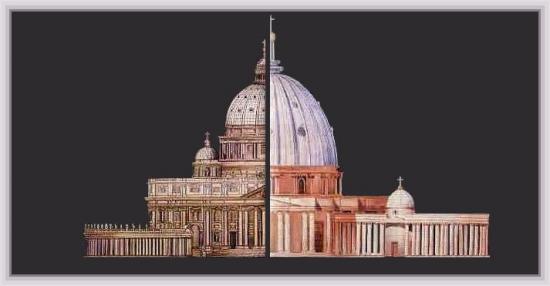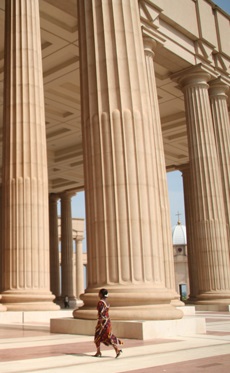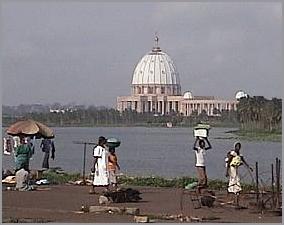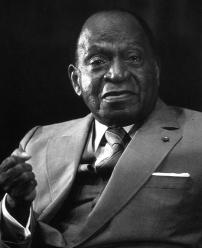 Ivorian President “did a deal with God” — by way of the Vatican Bank
Ivorian President “did a deal with God” — by way of the Vatican Bank
Realising that taking money from the dictator of a poor country was a “delicate matter”, a clever way was found to divert attention. In 1990, with great ceremony, the Pope laid the cornerstone of a hospital, a stone which sat alone in the field for more than twenty years.

St. Peter's in Rome | Our Lady of Yamoussoukro
The 1992 concordat concerns the largest church in the world — an African dictator’s answer to St. Peter’s Basilica. (After some jostling, a compromise was reached: the cupola above St. Peter’s dome in Rome is a bit higher, but Our Lady of Yamoussoukro has a tall cross mounted on top, making it higher overall.) The nave has a 50-kilogram gold cross hung beneath a glittering chandelier, huge, hand-blown stained-glass murals, and bronze and copper pillars so enormous that some of them conceal lifts. [1]
 The concordat protects from scrutiny the foundation that endows a cathedral built by the former president of the Ivory Coast in his native village of Yamoussoukro. It was a private arrangement made between the Vatican and the ailing President Félix Houphouët-Boigny who died the following year. This concordat
The concordat protects from scrutiny the foundation that endows a cathedral built by the former president of the Ivory Coast in his native village of Yamoussoukro. It was a private arrangement made between the Vatican and the ailing President Félix Houphouët-Boigny who died the following year. This concordat
♦ needs no ratification, that is to say, no legislative assent (Art. 16 )
♦ ensures that the foundation’s income and assets remain untaxed (Art. 9.1),
♦ keeps the church finances beyond the reach of both criminal and civil law (Art. 7.1)
♦ ensures that foundation funds can be sent out of the country (Art. 13.2),
♦ keeps all its documents “inviolable” (Art. 8).
Holding the financial documents secret is a canny move, since the cathedral cost some £87 million ($150 million), which the dictator raided from the national treasury.
A Vatican official is reported to have said, “The size and expense of the building in such a poor country make it a delicate matter”. [2]
 Hence the face-saving mention of amenities like a hospital “which may be freely associated with it” (Art. 2.2). That weasel clause means nothing, but to keep up appearances, when John Paul II blessed the completed cathedral on September 10, 1990, he also laid the foundation stone for the nearby hospital. That allowed him to take the money and shrug off all responsibility for what the concordat calls “possible eventualities” like a hospital.
Hence the face-saving mention of amenities like a hospital “which may be freely associated with it” (Art. 2.2). That weasel clause means nothing, but to keep up appearances, when John Paul II blessed the completed cathedral on September 10, 1990, he also laid the foundation stone for the nearby hospital. That allowed him to take the money and shrug off all responsibility for what the concordat calls “possible eventualities” like a hospital.
The consecrated stone lay alone in a field for more than twenty years until the beginning of construction in 2012. [3] The hospital was not built earlier because the money accepted by the Vatican is only for the cathedral. Yet the Pope’s ceremonial laying of the stone was superb public relations, since it gave the impression that the hospital was part of the deal.
The average Ivorian dies before the age of fifty. [4] The Cote d’Ivoire also has one of the highest maternal mortality rates in the world, [5] with untold suffering from birth injuries to both mother and child. There was no hospital to deal with medical emergencies like these — though, of course, for spiritual emergencies, the cathedral is provided with its own helopad. [6]
 St. Peter’s in Rome was under construction for over a century, but President Félix Houphouët-Boigny, managed to complete his cathedral in three years. It’s been suggested that the President who was eighty when the construction began, wanted an impressive setting for a grand state funeral. (It can hardly have been built for the mere 15 percent of the population that is Catholic.) And indeed, the gigantic building is said to only have been filled twice: for its inauguration by John Paul II and then for the funeral of its builder three years later.
St. Peter’s in Rome was under construction for over a century, but President Félix Houphouët-Boigny, managed to complete his cathedral in three years. It’s been suggested that the President who was eighty when the construction began, wanted an impressive setting for a grand state funeral. (It can hardly have been built for the mere 15 percent of the population that is Catholic.) And indeed, the gigantic building is said to only have been filled twice: for its inauguration by John Paul II and then for the funeral of its builder three years later.
The President also appears to have been concerned about the Hereafter. When asked about the source of this money, he reportedly replied: “I did a deal with God, and you wouldn’t expect me to discuss God’s business in public, would you?” [7]
This concordat ensures that the Vatican Bank, as well, will never have to discuss“ God’s business in public”.
Notes
1. Xan Rice, “The president, his church and the crocodiles”, New Statesman, 23 October 2008. http://www.newstatesman.com/africa/2008/10/houphouet-boigny-yamoussoukro
2. Richard N. Ostling, “The Basilica in the Bush”, Time Magazine, 3 July 1989.
http://jcgi.pathfinder.com/time/magazine/article/0,9171,958078-2,00.html
3. Better late than never: Africa’s largest and most grandiose church gets a new neighbour, Economist, 16 June 2012. http://www.economist.com/node/21556985
4. The life expectancy for Cote d’Ivoire in 2007 is estimated at 49.18 years, according to the US Government’s International Database. http://www.census.gov/cgi-bin/ipc/idbsprd
5. “UNICEF Cote d’Ivoire contribution to the reduction of maternal and neonatal mortality”, February 2007. http://www.unicef.org/wcaro/WCARO_CI_Prog_En_ReducingMaternalNeonatalMortality.pdf
6. Wes and Jill Walls, “A Three Year Backpacking Adventure Around The World”, entry for 20 November 2001. http://www.fullpassport.com/Trip2001/Diary/nov-20.html
7. Michael Agelasto, “The basilica at Yamoussoukro”, Africa, Spring 1999, Part III, Chapter 15. http://www.odyssei.com/travel-article/1268-17.html







